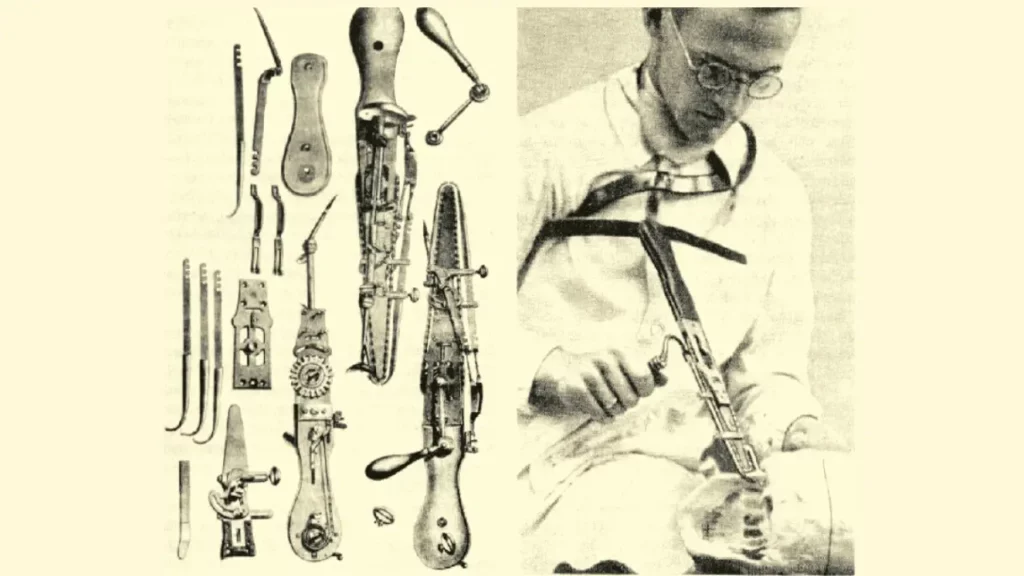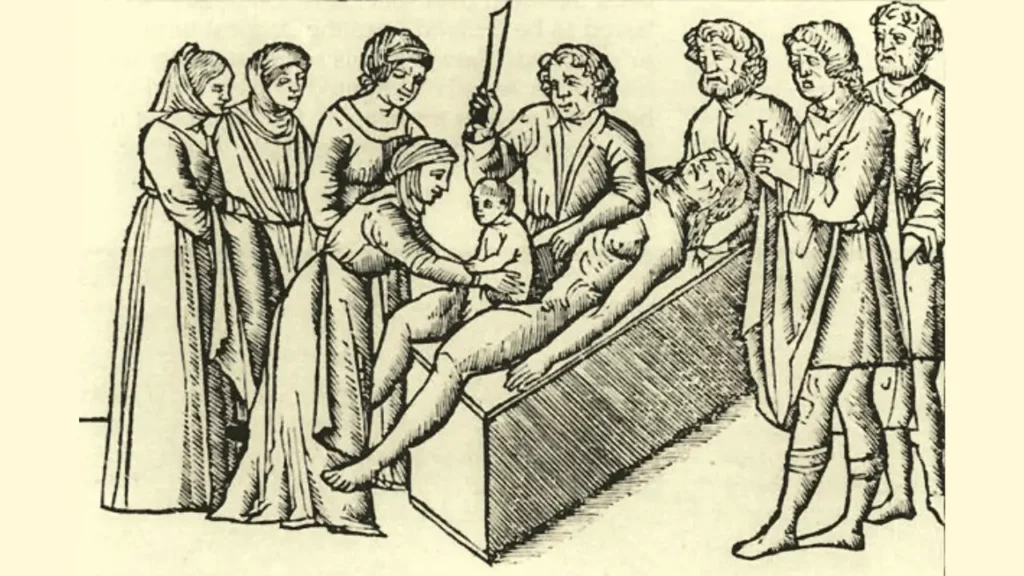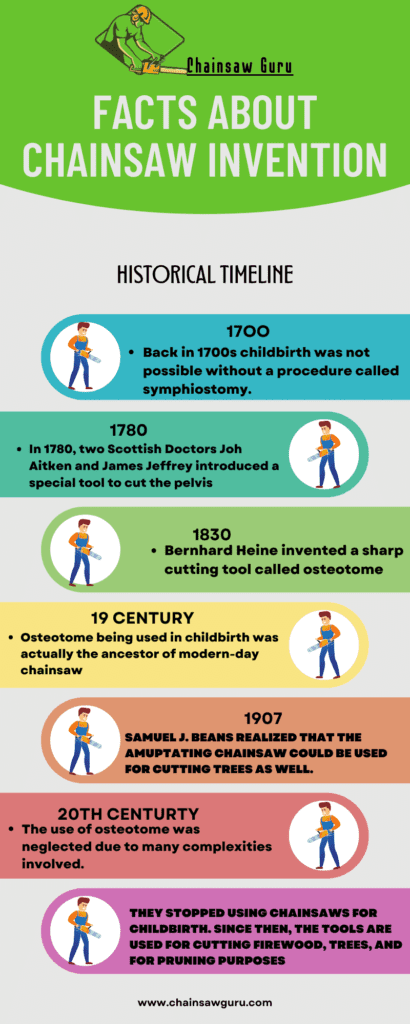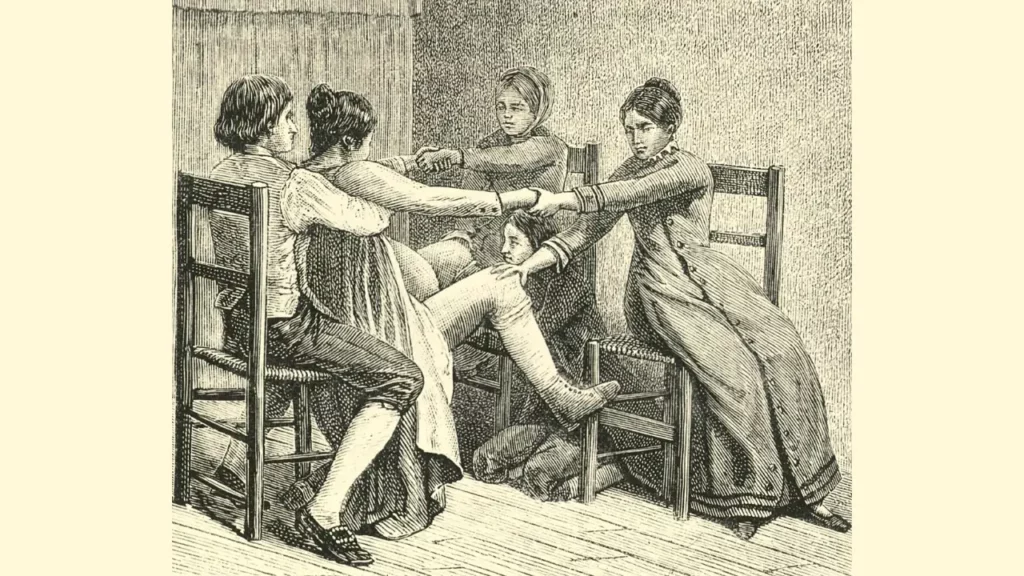Here to find out the real reason why were chainsaws invented?
Well, to your and almost everyone’s shock, “Chainsaws was firstly not invented for wood cutting but the opposite. The tool was first used to assist childbirth.”
Shocking, isn’t it?
Yes, you heard it right. The chainsaw that we now know was actually invented back in the 18th century to assist in a childbirth procedure called symphysiotomy.
Any time you hear the word chainsaw, your mind imagines its sharp blade and thrilling noise. It is terrifying to imagine the same thing was being used on the human body and not just for amputation but for a life-threatening procedure like childbirth.
The history of why were chainsaws invented is interesting, the scary factor aside, how it went from a surgical instrument to the tree hunter and woodcutter we know today is the topic of discussion today.

Have a look:
The Shocking Reason to Why Were Chainsaws Invented
The story goes back to 1700 when during childbirth, it was not always possible to save both the mother and her baby. A procedure called symphysiotomy was used to perform on a laboring mother in case natural delivery was not an option. The procedure widens the birth canal to take the baby out vaginally.
At first, this procedure was quite brutal, performed using a knife making it extremely painful and messy. Later on, in 1780 two Scottish doctors, John Aitken and James Jeffray introduced a tool to cut the pelvis.
They envisioned a rotating blade in comparison to already used sharp knives. And with this vision, the first chainsaw was invented. Though it was a success over traditional knife methods, not all doctors were able to do it due to its tricky use and dangerous nature. Plus it had a forever-lasting effect on the mothers.
Years later Bernhard Heine, a boy belonging to a medical family, spent most of his life studying under his orthopedic uncle Johann Heine introduced a new invention. He studied both medicine and orthopedic surgery.
With both of his areas of expertise combined in 1830, he invented a tool called osteotome or bone saw. It was created to cut through hard bones and was hand operated. Not only that, but it had sharp blades on a chain, wrapped around a metal surface the size of a kitchen knife. It used a crank handle to operate.

The tool was a success and won Heine a prestigious award in France and an invitation to Russia for its practical demonstration.
His invention took off and was adapted to multiple surgical procedures. For skull surgery, he added guards on the edges of the chain to protect the tissues from splintering the skull.
The procedure kept improving with time and played a significant role in 19th-century amputation. It now serves as a direct ancestor to the modern-day chainsaw.

What was the Original Use of Chainsaw?
It started out as a tool to help in a childbirth procedure called symphysiotomy. The pelvis was cut to widen the birth canal for natural birth. The procedure was dangerous, difficult to perform, and had long-lasting health issues. Hence it went out of practice for a few years.
In the case of childbirth, multiple new and careful methods were invented and performed. But in surgery and medical amputation, Heine’s bone saw clearly surpassed.
In 1907, Samuel J. Beans realized the use of an amputation chainsaw as a way of taking down trees,cutting firewood or hedges and filed his patent. With that chainsaw took on a new route, made exceptional advancements, and now is a huge market with numerous competitors.
Why were Chainsaws Invented in 1780?
During 18th-century childbirth, complications had very limited procedures. The surgery was mainly cutting the abdomen and then the uterus with hands or scissors. Neither of them was fast to save the baby’s life or spare the mother some pain. The odds of saving one of them were low let alone both.
To deal with that doctors John Aitken and James Jeffrey invented a knife-like chainsaw that rotates as it pierces through the bone. The purpose was to cut the pelvis in order to make space for the birth canal to widen for normal delivery instead of cutting the abdomen.

When did they stop using chainsaws for childbirth?
The use of chainsaws for childbirth, particularly for a procedure called symphysiotomy, stopped when medical practices and technology improved. Symphysiotomies were done in emergency situations where regular medical tools were not available or didn’t work well, usually in rural areas with limited access to hospitals.
But as time went on and the 20th century progressed, better methods for delivering babies and safer medical tools became available. This made the use of chainsaws for childbirth unnecessary. Doctors and nurses realized that using chainsaws had many risks, like losing a lot of blood, getting infections, and harming the health of the mother and baby.
By the middle to end of the 20th century, chainsaws were no longer used for childbirth. Safer procedures like cesarean sections became more common instead. Chainsaw-assisted childbirth became a thing of the past as medical knowledge and healthcare improved.
Frequently Asked Questions
What did the first chainsaw look like?
The first chainsaw, known as the “endless chain saw,” had a design resembling a large, stationary cutter. It consisted of a serrated chain that was driven by a hand-cranked mechanism. The chain, with cutting teeth attached, looped around a guide bar, which allowed it to move in a continuous motion. This early chainsaw required two people to operate—one to turn the crank and the other to guide the cutting action. While it represented an innovation in its time, the design and functionality of the first chainsaw were far more primitive compared to the portable and motorized chainsaws we are familiar with today.
Who invented the first chainsaw and why?
John Aitken and James Jeffray, the two Scottish doctors invented chainsaws to operate C-sections on women back in 1780.
Moreover, the first chainsaw prototype was invented by a German orthopedic surgeon named Bernhard Heine in 1830. Heine designed it as a surgical tool for procedures like symphysiotomies and amputations. His invention aimed to improve the efficiency and precision of surgical interventions, especially in situations where traditional manual tools were inadequate. This early chainsaw was primarily intended for medical purposes rather than the tasks we associate with chainsaws today.
Who manufactured the first chainsaw for cutting trees?
Samuel J. Beans 1907 filed the first patent for the wood cutting chainsaw. However, the first gas-powered chainsaw designed for tree cutting was manufactured by Andreas Stihl AG & Co. KG. Founded by Andreas Stihl in 1926, the company introduced a portable and gasoline-powered chainsaw called the “Stihl A.” This innovation revolutionized the logging industry, making tree felling and woodcutting more efficient and effective. Stihl became a prominent manufacturer of chainsaws, playing a key role in the widespread adoption of chainsaw use across industries.
Are chainsaws still used for childbirth?
No, they are not. Might be in third world countries where resources are very limited but that is very unlikely as well. We have not seen that chainsaw has been used for childbirth in 2024 and from that, it’s apparent that they are limited to cutting trees or yardwork only.
Do they still use chainsaws for medical purposes?
For amputation yes, but it has taken on an advanced form. But in childbirth no, even for third world countries it is unlikely. Chainsaws these days are mostly used for cutting big trees, for yardwork, or for pruning hedges, etc. The latest models do not have any part in medical sciences as technology has advanced now with better equipment.
Is, “why were chainsaws invented?” the most popular search in the United States?
A bit weird, but yes. The question was searched by millions of people with a sudden rise in trend of why were chainsaws invented joke. Though it should not be taken as a joke because the very first use of a tool like chainsaw was to ensure a smooth childbirth process. Regardless of that, people have searched for this query and are still searching it with a high trend in 2024.
Why were chainsaws invented fact check?
The only fact check behind the invention of chainsaws is that the tool was used to amputate the childbirth canal in order to help in child delivery. But those were old times and now the tool is barely used for medical purposes. Its use shifted more towards heavy-duty wood-cutting work though.
What was the original concept of the chainsaw?
The initial concept behind the chainsaw was to invent a tool that could assist in surgical procedures, such as amputations and orthopedic surgeries. The goal was to create a mechanized device that would offer a more efficient and precise alternative to the manual methods used during that era. The aim was to save time and enhance surgical interventions by introducing a powered cutting tool.
Final Takeaways: Why Were Chainsaws Invented?
The chainsaw has come a long way starting back in the 1700s as a small surgical instrument to now not only as a woodcutter and tree hunter but also as a famous murder weapon featured in movies.
In addition, the intent behind this invention was to make long complicated labor less time-consuming with symphysiotomy and to increase the chances of saving both mother and her child. Although it was successful in that manner, it left the mother with a forever-lasting effect due to cutting the pelvis.
Moreover, this procedure was later on labeled too dangerous and stopped but its use in amputation and bone cutting is still in use today with more advancements every day.
Finally, the same idea behind amputation was adapted later on in the Chainsaw market that we now know today offering unlimited options with unlimited features.
References
- Crowe, M. P. (1983). The chainsaw in Australia. Australian Forestry, 46(1), 14-24.
- Kranjec, J., & Porsinsky, T. (2011). History of Chainsaw Development/Povijest razvoja motorne pile lancanice. Nova Mehanizacija Sumarstva, 32, 23-38.
- Donahue, B. (2011). Historian with a Chainsaw: Teaching Environmental History in the Field. OAH Magazine of History, 25(4), 33-35.
- Treating your pain during labor and Delivery. University of Iowa Hospitals & Clinics. (n.d.). Retrieved December 22, 2022, from https://uihc.org/health-topics/treating-your-pain-during-labor-and-delivery#:~:text=The%20medications%20may%20make%20the,%2C%20and%20Stadol%20(butorphanol)
- “Chainsaws Were Originally Invented for Childbirth in an Era Before Sanitation and Antibiotics.” IFLScience, 10 Feb. 2021, iflscience.com/we-regret-to-inform-you-that-chainsaws-were-originally-invented-for-childbirth-58685.
- “The Western Journal of the Medical and Physical Sciences.” Google Books, books.google.com/books/about/The_Western_Journal_of_the_Medical_and_P.html?id=teUJAQAAMAAJ.
- IMOUMLIVE Mini Chainsaw Review: [Fast, Compact, Lightweight] - December 11, 2023
- 10 Types of Chainsaw Explained in Detail for Homeowners - January 23, 2023
- What is Chainsaw Rake? A Guide for Beginners - January 21, 2023
